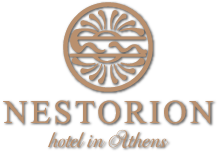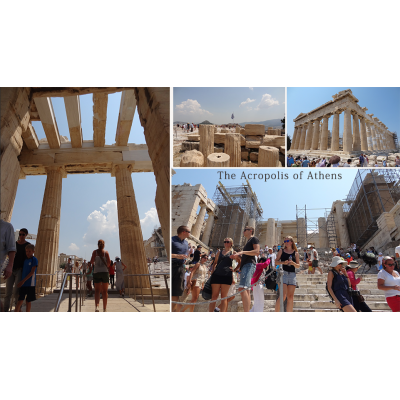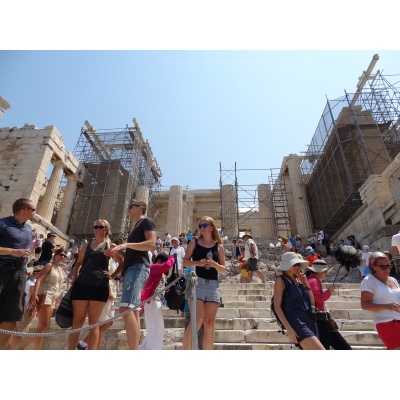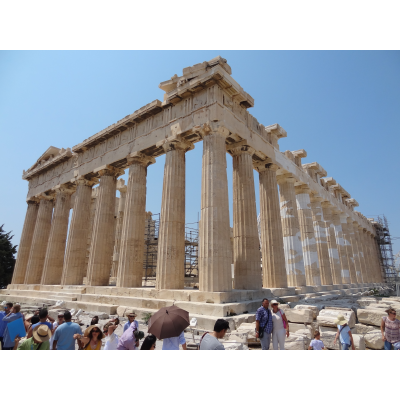The Acropolis of Athens
the budget hotel in athens
The following text has been written by I. Trianti (Ministry of Culture of Greece) and serves to general promotional touristic purposes. Photos are taken on 26.07.2015 by Nestorion Hotel http://www.nestoriohotel.gr and they are for free copy.
"The sacred rock of the Acropolis was for many centuries the most important religious centre of the city of Athens,. The first traces of occupation go back to the Neolithic period. In Mycenaen times it was the seat of the king, whose megaron stood roughly on the site on which the Erechtheion was built many centuries later. After the 11th c. BC. it became the home of the cult Athena, patron goddess of the city that took her name, and of others gods, and was adorned down to the end of antiquity with majestic temples, brilliant buildings, and a vast number of votive monuments. In the middle of the 5th c.BC., when Athens was at the height of its power, the ambitious artistic programme of Perikles was implemented: the Parthenon, the Propylaea and, a little later, the temple of Athena Nike and the Erechtheion, were all erected between 447 and 406 BC, remaining to the present day witnesses to the Greek Classical civilization.
Entrance to the Acropolis is from the west, by way of Propylaea. This building was the work of the Architect Mnesikles and was erected in the years 437-432 BC. It consists of the central building and two wings. The north wing had paintings or frescoes on its walls, and is therefore Known as a Pinakotheke ("Art Gallery").
The small Ionic temple of Athena Nike was erected to the south of Propylaea about 420 BC. The architect of this temple was Kalikrates. It had four Ionic columns of both the front and back. A marble protective balustrade with relief figures of Nike encircled the top of the bastion on which the temple was built.
The Parthenon, a temple dedicated to the goddess Athena, was the earliest of the Classical Monuments on the Acropolis, which were built in the second half of the 5th c. BC to replace the earlier buildings destroyed when the Persians burned the Athenian Acropolis, in the 480 BC. Pericles was the inspiration behind the building of the temple and the work was directed by Pheidias. The architects of the Parthenon, which was constructed and decoreted between 447 and 432 BC, were Iktinos and Kallikrates. The Parthenon is a Doric Peristyle temple with eight (8) columns on the ends and seventeen (17) on the sides. The columns, walls and sculptural decoration are of white Pentelic marble.
All the upper parts of the temple were decorated. On the outside, the metopes were carved with the battle of the gods and the Giants (Gigantomachy) on the east side, of the Lapinths and Centaurs (Centauromachy) on the south, of the Athenians and Amazons (Amazonomachy) on the west and the Trojan War on the north side.
The two pediments had scenes from myths connected with the goddess Athena: the birth of the goddess in the presence of the other gods, on the east pediment, and her contest with Poseidon for Athens on the west. The walls of the cella were encircled by a relief frieze depicting the Panathenaic procession. The chryselephantine statue of the goddess by Pheidias stood inside the temple.
The Erechtheion was built about 420 BC on the north side of the summit of the hill and housed earlier cults. It is an Ionic temple, with a complex design. On the east side is a porch, with six Ionic columns, on the north a monumental propylon and on the south a porch, the roof of which is supported by six figures of the maidens, the famous Caryatids. The cella was divided into two parts, in which Athena and Poseidon - Erechtheus were worshipped.
The space between the large sanctuaries mentioned above was filled smaller sanctuaries and other buildings as well as with bronze statues dedicated to the gods". TEXT: I.TRIANTI, from ISBN 978-960-386-103-4 Photos: Nestorion Hotel
"The sacred rock of the Acropolis was for many centuries the most important religious centre of the city of Athens,. The first traces of occupation go back to the Neolithic period. In Mycenaen times it was the seat of the king, whose megaron stood roughly on the site on which the Erechtheion was built many centuries later. After the 11th c. BC. it became the home of the cult Athena, patron goddess of the city that took her name, and of others gods, and was adorned down to the end of antiquity with majestic temples, brilliant buildings, and a vast number of votive monuments. In the middle of the 5th c.BC., when Athens was at the height of its power, the ambitious artistic programme of Perikles was implemented: the Parthenon, the Propylaea and, a little later, the temple of Athena Nike and the Erechtheion, were all erected between 447 and 406 BC, remaining to the present day witnesses to the Greek Classical civilization.
Entrance to the Acropolis is from the west, by way of Propylaea. This building was the work of the Architect Mnesikles and was erected in the years 437-432 BC. It consists of the central building and two wings. The north wing had paintings or frescoes on its walls, and is therefore Known as a Pinakotheke ("Art Gallery").
The small Ionic temple of Athena Nike was erected to the south of Propylaea about 420 BC. The architect of this temple was Kalikrates. It had four Ionic columns of both the front and back. A marble protective balustrade with relief figures of Nike encircled the top of the bastion on which the temple was built.
The Parthenon, a temple dedicated to the goddess Athena, was the earliest of the Classical Monuments on the Acropolis, which were built in the second half of the 5th c. BC to replace the earlier buildings destroyed when the Persians burned the Athenian Acropolis, in the 480 BC. Pericles was the inspiration behind the building of the temple and the work was directed by Pheidias. The architects of the Parthenon, which was constructed and decoreted between 447 and 432 BC, were Iktinos and Kallikrates. The Parthenon is a Doric Peristyle temple with eight (8) columns on the ends and seventeen (17) on the sides. The columns, walls and sculptural decoration are of white Pentelic marble.
All the upper parts of the temple were decorated. On the outside, the metopes were carved with the battle of the gods and the Giants (Gigantomachy) on the east side, of the Lapinths and Centaurs (Centauromachy) on the south, of the Athenians and Amazons (Amazonomachy) on the west and the Trojan War on the north side.
The two pediments had scenes from myths connected with the goddess Athena: the birth of the goddess in the presence of the other gods, on the east pediment, and her contest with Poseidon for Athens on the west. The walls of the cella were encircled by a relief frieze depicting the Panathenaic procession. The chryselephantine statue of the goddess by Pheidias stood inside the temple.
The Erechtheion was built about 420 BC on the north side of the summit of the hill and housed earlier cults. It is an Ionic temple, with a complex design. On the east side is a porch, with six Ionic columns, on the north a monumental propylon and on the south a porch, the roof of which is supported by six figures of the maidens, the famous Caryatids. The cella was divided into two parts, in which Athena and Poseidon - Erechtheus were worshipped.
The space between the large sanctuaries mentioned above was filled smaller sanctuaries and other buildings as well as with bronze statues dedicated to the gods". TEXT: I.TRIANTI, from ISBN 978-960-386-103-4 Photos: Nestorion Hotel





